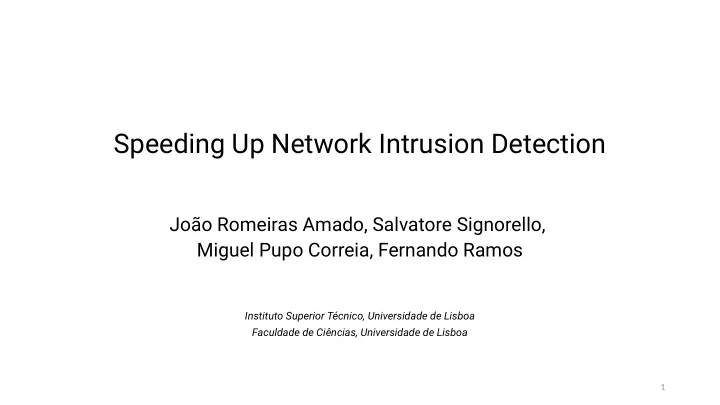

Speeding Up Network Intrusion Detection João Romeiras Amado, Salvatore Signorello, Miguel Pupo Correia, Fernando Ramos Instituto Superior Técnico, Universidade de Lisboa Faculdade de Ciências, Universidade de Lisboa 1
Short-lived network attacks are becoming increasingly common, while existing solutions often take several minutes to perform detection. Motivation R. Miao, R. Potharaju, M. Yu, and N. Jain, “The dark menace: Characterizing network- based attacks in the cloud,” in Proceedings of the 2015 Internet Measurement Conference , ser. IMC ’15, 2015. M. Moshref, M. Yu, R. Govindan, and A. Vahdat, “Trumpet: Timely and precise triggers in data centers,” in Proceedings of the 2016 ACM SIGCOMM Conference , ser. SIGCOMM ’16, 2016. • Increasing sophistication of recent attacks Packet sampling’s coarse-grained view of the network reduces the effectiveness of intrusion detection. • Need for fast atuack detectjon Sampling introduces a fundamental bias, resulting in degraded performance. • Quality of measurement data Daniela Brauckhoff, Bernhard Tellenbach, Arno Wagner, Martin May, and Anukool Lakhina. 2006. Impact of packet sampling on anomaly detection metrics. In Proceedings of the 6th ACM SIGCOMM conference on Internet measurement. 159– 164. Anna Sperotto, Gregor Schaffrath, Ramin Sadre, Cristian Morariu, Aiko Pras, and Burkhard Stiller. 2010. An overview of IP fmow-based intrusion detection. IEEE communications surveys & tutorials 12, 3 (2010), 343–356. J. Mai, C.-N. Chuah, A. Sridharan, T. Ye, and H. Zang, “Is sampled data suffjcient for anomaly detection?” in Proceedings of the 6th ACM SIGCOMM Conference on Internet Measurement, ser. IMC ’06, 2006. 2
S witch- P owered I ntrusion D etection • Intrusion detection framework powered by programmable switches • Push-based measurement approach, reconfjgurable at runtime • Machine Learning-based traffjc analysis • Focus on fast attack detection 3
System Design and Architecture 4
Switch-Powered Intrusion Detection Machine learning-based SPID’s Control Plane 4 traffjc analysis. Machine Learning Pipeline Anomaly Detection Stage Classifjcation Stage Pre-Processing Stage Push-based switch-driven statistics collection. Runtime confjg. of the Push-driven 2 3 Counter A Counter B CM-Sketch BM-Sketch Measurements primitives collection SPID’s Data Plane Rich set of packet 1 Measurement Primitives { } summaries stored in the & forwarding behavior { } switches, reconfjgurable at runtime. Switch’s Forwarding Pipeline 5
Measurement Primitives Flow Statistics Sketching Algorithms Number of packets/bytes Count-min Source/Destination IP Bitmap IP Protocol AMS Source/Destination Ports K-ary TCP Flags MV-Sketch ICMP Type/Code HyperLogLog (…) (…) The operator is able to reconfjgure the active counters on all switches at runtime. Each switch can be optimized for different monitoring purposes. 6
Measurement Primitives and Runtime Confjg. Each switch’s available memory is dynamically allocated between all active counters. Runtime confjg. of the 2 Counter A Counter B CM-Sketch BM-Sketch primitives The operator is able to reset all counters during runtime. SPID’s Data Plane 1 Measurement Primitives { } & forwarding behavior { } Switch’s Forwarding Pipeline 7
Push-driven Measurement Collection Traffjc change detection sketches will serve as triggers for the push-based collection. Faster alerts Push-driven Switch Proactiveness 3 Counter A Counter B CM-Sketch BM-Sketch Measurements collection SPID’s Data Plane Relieves the control plane of the burden of performing polling actions. Switch’s Forwarding Pipeline 8
Goal: Perform fmow aggregation according to their characteristics, Machine Learning Pipeline aiming to detect potential anomalies in the form of outliers. SPID’s Control Plane 4 Machine Learning Pipeline The pipeline is immediately Anomaly Detection Stage Classifjcation Stage Pre-Processing Stage executed when a trigger event is received from the data plane. Counter A Counter B CM-Sketch BM-Sketch SPID’s collection of multiple measurement primitives is essential to increase the number and variety of network features available as input to the detection system. 9
Preliminary Evaluation 10
Preliminary Evaluation The evaluation was performed with real • Detection of unknown attacks traffjc datasets containing multiple labeled attack instances. • Stream-based over sample-based While SPID observes all packets, we • Detection time also tested a sample-based approach that performed a sample of 1/500 packets . 11
Evaluation: Detection of Unknown Attacks Across tested attacks, SPID always has a higher Attack Type Solution TP FP Precision Recall precision percentage than TCP SYN Flood SPID 40.0% 66.0% 37.7% 99.0% the other baseline NIDS. CM Sketch 30.0% 69.7% 30.1% 98.6% Sampling 0.0% 100% 0.0% 0.0% Ping-of-Death SPID 93.3% 44.8% 67.5% 99.9% A combination of multiple CM Sketch 30.0% 94.2% 24.2% 98.2% measurement primitives Sampling 46.7% 68.4% 40.6% 94.4% is much better than any single metric. Very preliminary results with a basic ML approach! 12
Evaluation: Detection Time Sampling: The detection time of a sampling-based approach is inherently constrained by the sampling frequency. On average, SPID’s initial detection is >10x faster than traditional methods. SPID: A push-driven approach detects anomalous patterns as soon as they emerge in the data plane. 13
Current Status Our preliminary experiments offer confjdence on the potential of programmable switches in improving network-based IDSs, namely given: a) The ability to collect and reconfjgure during runtime a diversity of different measurements at the switch-level, including sketching algorithms, points towards an improvement in detection precision b) Potential of a push-driven approach to speed up intrusion detection c) Use of anomaly detection techniques to fjlter alerts from the data plane, allowing the operator to focus only on the more relevant traffjc statistics 14
Future Work • Design and implementation of additional (and refjnement of existing) measurement primitives in P4, along with lightweight traffjc change detection algorithms to enable better data plane triggers • Deployment and testing of SPID on P4-programmable hardware • Explore modern anomaly detection approaches to improve the precision of SPID to the level required by intrusion detection environments 15
Recommend
More recommend